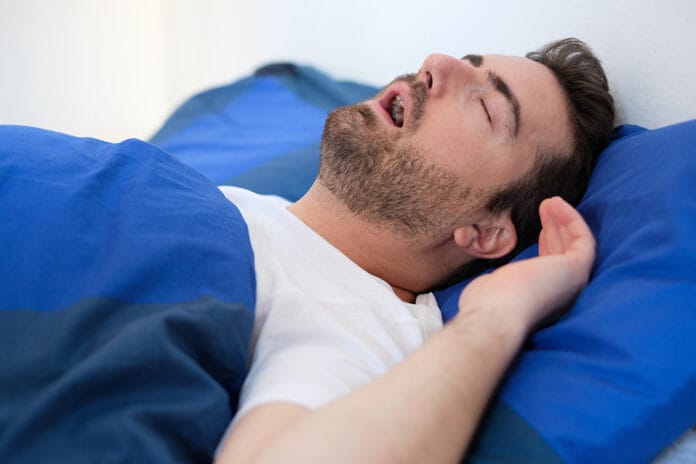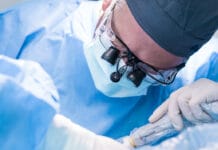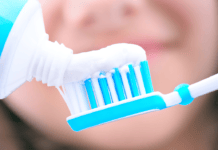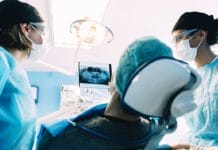Dental professionals have a front seat view of the oral manifestations of underlying medical conditions, and obstructive sleep apnea is one of them. When conducting a dental screening, some common oral symptoms of a sleeping disorder include the signs below.
Flat, worn teeth ‒ Bruxism is a natural side effect of oxygen deprivation during episodes of sleep apnea. Since the teeth clench tightly against one another, it’s just a matter of time before wear facets, flattened enamel, and chipped teeth become visible.
TMJ concerns ‒ Along with enamel wear, people with sleep-disordered breathing typically experience symptoms of TMD. Extensive clenching of the teeth strains the muscles around the joint, placing additional tension on the TMJ itself. Hygienists may notice enlarged masseter muscles, popping or clicking upon palpation of the joints, or a patient who complains of frequent jaw pain, headaches, and earaches.
Enlarged tonsils and a wide neck circumference ‒ Soft tissue blockage is the main factor contributing to obstructive sleep apnea (OSA). As such, any time there are enlarged tissues at the back of the mouth or around the throat, there is an added risk of reduced oxygen flow whenever the patient is sleeping.
Narrow arches or crowded teeth ‒ Similar to the airway blockage from soft tissues, a smaller oral environment due to structural anatomy can also make certain people more predisposed to a sleeping disorder, especially those with a small mandible or narrow palate. Research shows that people who are 30 years or older who have some type of jaw deformity (including a “short face” or overbite) are significantly more at risk of suffering from a sleeping disorder.1
If patients present with any of the above symptoms, it’s also worthwhile to question and screen them for other warning signs, such as:
- Fatigue
- Mood changes, such as irritability, anxiety, or depression
- Snoring
- High blood pressure
- History of cardiovascular disease
- Headaches and migraines
Easing Patients’ Minds About a Medical Referral
Until recently, most people who suspected that they had a sleeping disorder had to complete an overnight sleep study in a medical facility. While hospital and clinic-based sleep studies are still conducted (especially on children), they are not always the norm for adults with snoring or mild sleep apnea symptoms.
It comes as a pleasant surprise that people can complete a formal sleep test in the comfort of their own homes. Home sleep studies are readily used today, although not many people are familiar with this alternative testing. When patients understand that they can sleep in their own bed (without a medical provider watching them on a camera), they’re usually more likely to pursue a medical sleep diagnosis.
All of that being said, sleep studies must still be ordered by a licensed physician. Sleep studies may be recommended in patients who present with more than two to three symptoms of a sleeping disorder, especially if the patient complains of persistent symptoms. The unit is sent home with the patient overnight, worn as directed, then returned to the clinic for formal interpretation and diagnosis. Usually, the unit has a small attachment worn on the finger and wrist, with a sensor placed on the upper chest.
How Dental Offices Can Help
Sleep dentistry appliances such as mandibular advancement devices treat obstructive sleep apnea at its source. By guiding the mandible in a slightly forward position, it’s possible to alleviate airway blockage at the back of the throat where soft tissues collapse and physically restrict oxygen flow.
Herein lies the dilemma. Oral appliances for sleep apnea can only be fitted and delivered by a dentist. But the prescription must come from a medical doctor. Since physicians can easily prescribe alternatives such as CPAP machines, most patients with a clinical sleeping disorder rely on these devices instead of one fitted for their mouths. However, many CPAP users find the machines cumbersome and, as a result, are noncompliant with the prescribed use. Oral sleep appliances tend to be less inhibitive; in turn, patients are more likely to wear them each night.
By dental practices partnering with local sleep physicians and clinics, patients can access a more discreet ‒ and effective ‒ treatment for their obstructive sleep apnea. Working together streamlines patients’ screening and testing process while also offering an alternative treatment that individuals are likely to be more compliant about using.
Unmanaged sleep apnea can significantly increase the risk of a life-threatening cardiovascular event. Unfortunately, not everyone realizes how serious the condition can be. By educating patients about how oral anatomy affects oxygen flow, individuals can take a proactive step toward healthier, quality sleep. It’s easier than ever to conduct a sleep study, and there are effective alternatives to traditional CPAP machines.
Now Check Out the Peer-Reviewed, Self-Study CE Courses from Today’s RDH!
Listen to the Today’s RDH Dental Hygiene Podcast Below:
References
- Posnick, J., Adachie, A., Singh,N., et al. “Silent” Sleep Apnea in Dentofacial Deformities and Prevalence of Daytime Sleepiness After Orthognathic and Intranasal Surgery. Craniomaxillofacial Deformities/Sleep Disorders/Cosmetic Surgery. 2018 Apr; 76(4): 833-843. https://www.aaoms.org/media/press-releases/joms-study-silent-sleep-apnea-prevalent-in-patients-with-jaw-deformity












